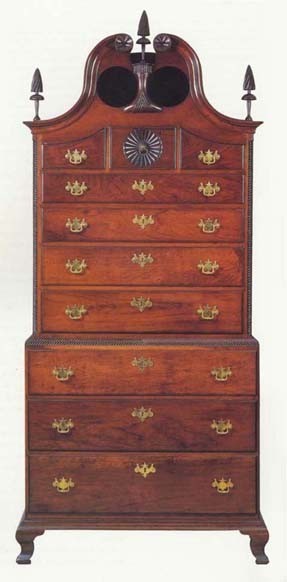
Chest-on-chest-on-frame attributed to Elisha DeWolf Jr. (1772–1855), inscribed for “L.[ucy] D.[eWolf] Allis,” Conway or Ashfield, Massachusetts, ca. 1800. Cherry with white pine. H. 85", W. 40", D. 22 1/2". (Courtesy, Historic Deerfield, Inc.; photo, Amanda Merullo.) The style of furniture made in New York during the last quarter of the eighteenth century was fashionable in the Connecticut River Valley, where this cabinetmaker reoriented the concept of a gadrooned base molding to serve as a mid-molding between the two cases. www.historic-deerfield.org

Chest-on-chest attributed to Daniel Clay (1770–1848), Greenfield, Massachusetts, 1792–1800. Cherry with yellow poplar. H. 74", W. 45", D. 18 3/4". (Courtesy, Historic Deerfield, Inc., bequest of Rowena Russell Potter; photo, Helga Studio.) www.historic-deerfield.org
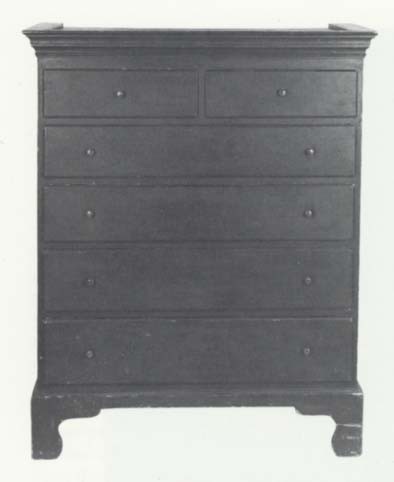
Chest of drawers inscribed “Made in the Year 1800, By Mr. John Cardwill for Mr. Willis Griswold of Middletown In Vermont.” Cherry with white pine. H. 38 1/2", W. 38 1/2", D. 19". (©Shelburne Museum, Shelburne, Vermont, www.shelburnemuseum.org)

Card table, probably Rutland, Vermont, 1805–1815. Cherry and mahogany veneer with white pine, yellow poplar, and yellow birch. H. 27 7/8", W. 36 5/16", D. 17 3/16" [closed]. (Courtesy, Bennington Museum; photo, Ken Burris.) Card tables with five legs were especially popular in New York City and the Hudson Valley, and they influenced design in western Vermont.
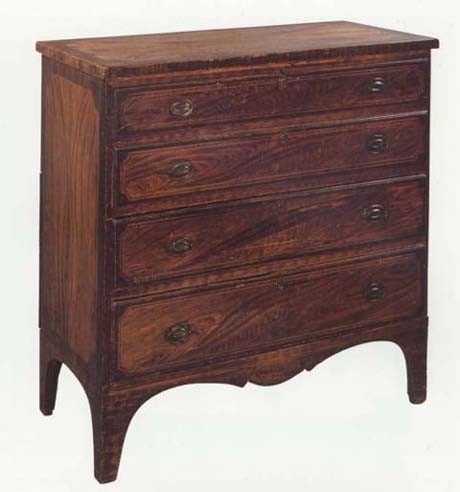
Chest with two drawers, Shaftsbury, Vermont, ca. 1825. Painted white pine. H. 41", W. 41 1/8", D. 19 1/4". (Courtesy, Bennington Museum; photo, Blake Gardner.) The Matteson family of carpenters and ornamental painters have been credited with producing this type of furniture, which was made throughout northern New England.

Secretary made by Anthony Van Doorn (1792–1871), Brattleboro, Vermont, 1836–1847. Mahogany and mahogany veneer with yellow poplar, basswood, and white pine. H. 55 3/8", W. 45", D. 22 3/4". (Courtesy, Historic Deerfield, Inc., gift of Dr. and Mrs. Gary Russolillo; photo, Amanda Merullo.) www.historic-deerfield.org

Side chair attributed to John Gaines II or Thomas Gaines I, Ipswich, Massachusetts, 1720–1745. Maple and white pine. H. 46", W. 18 1/4". (Courtesy, John Whipple House, Ipswich Historical Society, Ipswich, MA; photo, Richard Cheek.) The chair descended in the Appleton family of Ipswich.

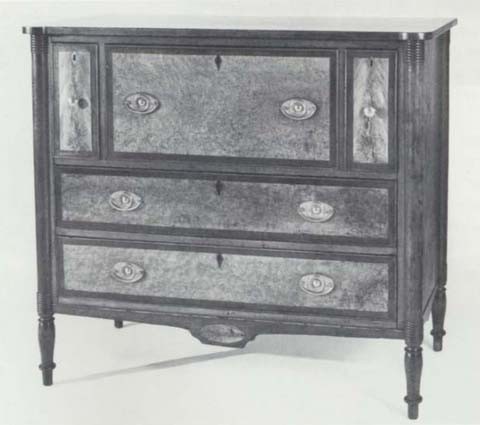
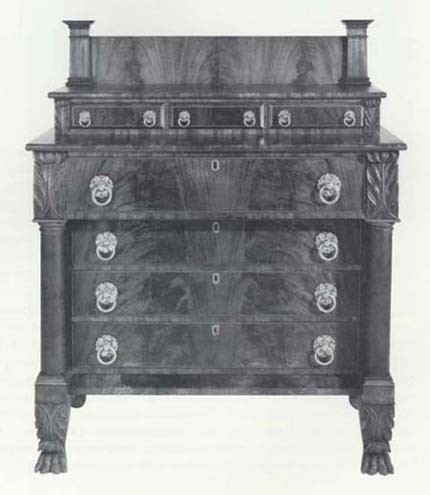
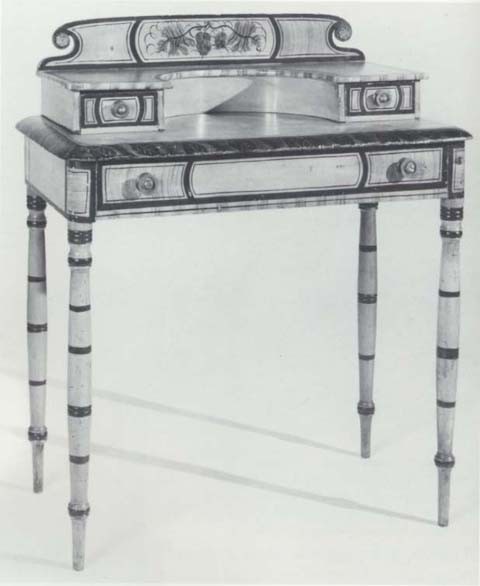

Chest of drawers with Thomas Giddings family register engraved in marble, Hartland, Connecticut area, 1812–1818. Cherry and marble with yellow poplar. H. 39", W. 43 3/8", D. 24 1/8". (©Shelburne Museum, Shelburne, Vermont, www.shelburnemuseum.org, photo, Ken Burris.)

Chest of drawers made by Erastus Grant, Westfield, Massachusetts, 1799; inscribed “E Grant/Oct 11 1799,” “Grant/Novr 2, 1799,” and “E Grant Cabinet Maker.” Cherry, cherry veneer, and whitewood stringing with yellow poplar and white pine. H. 35", W. 43 1/4", D. 23 1/2". (Courtesy, Historic Deerfield, Inc., Mr. and Mrs. Hugh B. Vanderbilt Fund for Curatorial Acquisitions; photo, Amanda Merullo.)




Chest of drawers, New England, ca. 1810. (a) Front and (b) back views. White pine. H. 39 1/4", W. 36 3/4", D. 181/4". (©Shelburne Museum, Shelburne, Vermont. www.shelburnemuseum.org; photo, Ken Burris.)
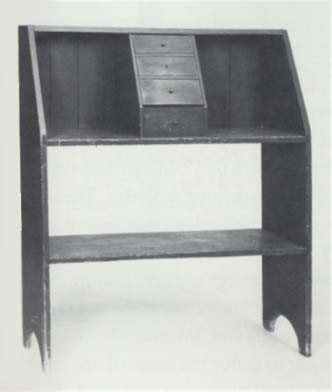
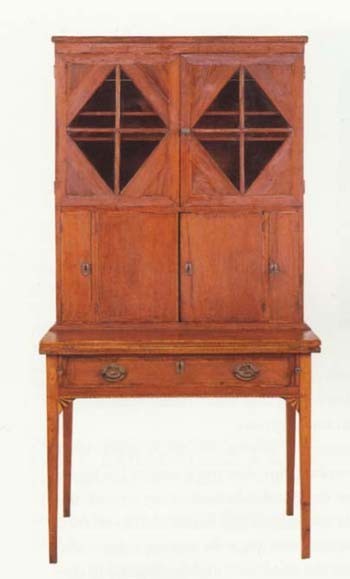
Secretary made by William Lloyd and Luther Bliss, Springfield, Massachusetts, 1804. Cherry, mahogany veneer, and whitewood inlay with white pine. H. 70 1/8", W. 36 1/4", D. 18 1/8". (Private collection; photo, David Stansbury.)

Chest of drawers made by Stephen Tracy, branded “S.TRACY” and stamped “EADAMS [reversed S],” Lisbon, Connecticut, or Cornish, New Hampshire, ca. 1806. Cherry with white pine. H. 34 7/8", W. 39 3/8", D. 20 3/4". (Courtesy, Historic Deerfield, Inc., Mr. and Mrs. Hugh B. Vanderbilt Fund for Curatorial Acquisitions; photo, Amanda Merullo.) www.historic-deerfield.org
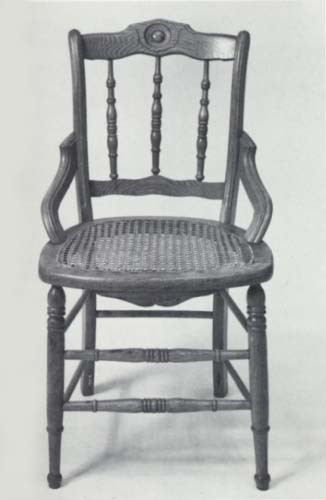
Side chair, Canterbury, New Hampshire, 1875–1900. Oak. H. 32 1/2", W. 17 3/4", D. 16 3/4". (Collection of Shaker Village, Inc., Canterbury; photo, Bill Finney, courtesy, New Hampshire Historical Society.)

Armchair, Massachusetts, ca. 1780 and ca. 1825. Cherry with pine. H. 38 1/4", W. 22, D. 23 1/4". (Courtesy, Historic Deerfield, Inc., gift of H. William Strong Jr.; photo, Amanda Merullo.) historic-deerfield.org
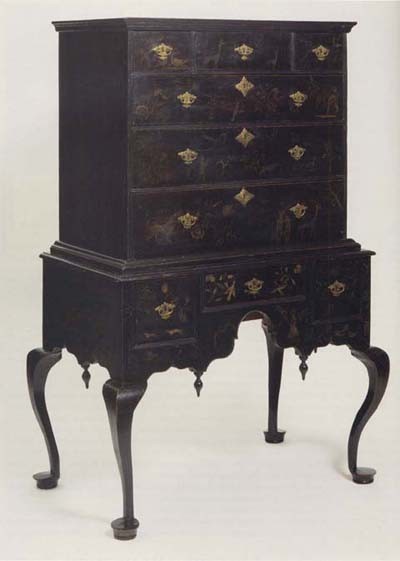
High chest of drawers, Windsor or East Windsor, Connecticut, 1736. Maple with yellow pine. H. 59", W. 41 3/8", D. 22". (Courtesy, Winterthur Museum.)


Tall clock made by Jonathan Blasdel Jr. (1709–1802), East Kingston, New Hampshire, 1768. Maple with white pine. H. 81 1/2", W. 17 1/2", D. 10". (Courtesy, New Hampshire Antiquarian Society; photo, Bill Finney.)

Side chair, Portsmouth, New Hampshire area, 1740–1790. Maple. H. 41 1/2", W. 15 3/4", D. 13". (Courtesy, Historic Deerfield, Inc.; photo, Helga Photo Studio.) www.historic-deerfield.org
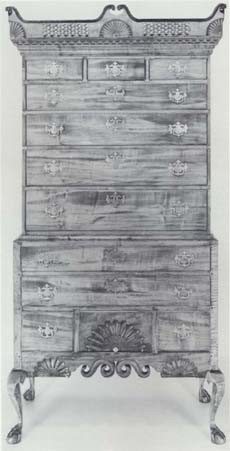
High chest of drawers made by William Houston and J. Miller in the shop of Major John Dunlap, Bedford, New Hampshire, 1780. Maple with white pine. H. 83 1/4", W. 41 7/8", D. 201 5/16". (Courtesy, Winterthur Museum.) The chest is inscribed “Wllm Houston” and “J Miller 1780.”
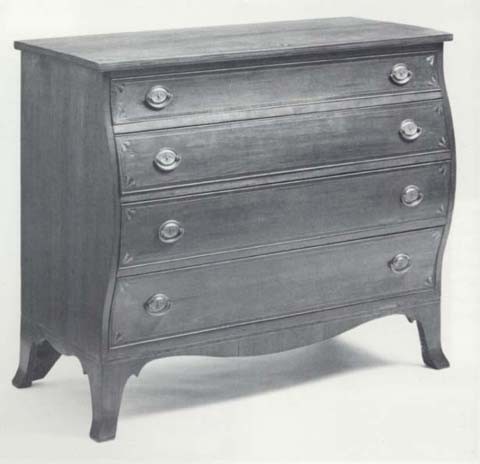
Chest of drawers “Made by G [eorge] Stedman/ Norwich/ Vt,” 1816–1822. Cherry, mahogany veneer, and whitewood inlays with white pine. H. 34 7/8", W. 41 3/4", D. 20 1/8". (Courtesy, Winterthur Museum.)
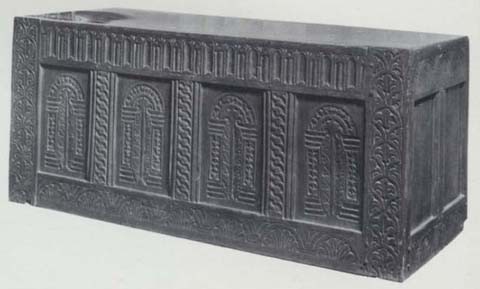
Chest, Windsor, Connecticut, ca. 1650. White oak. H. 23 3/4", W. 54", D. 23". (Courtesy, Pocumtuck Valley Memorial Association, Memorial Hall Museum, Deerfield, Massachusetts, gift of Mrs. Catherine W. Hoyt; photo, Helga Studio.) The legs and lid are lost.
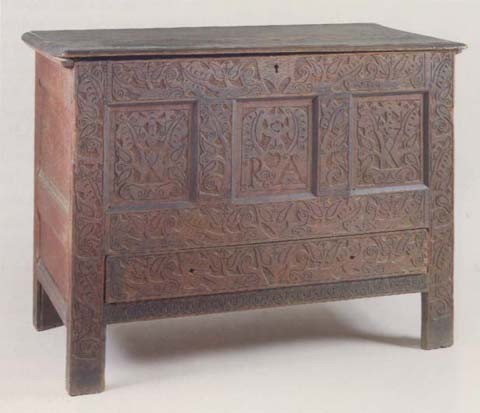
Chest with drawer, inscribed “RA,” Hadley or Hatfield, Massachusetts, ca. 1700. Red oak with yellow pine. H. 34", W. 47 1/4", D. 20 1/2". (Courtesy, Pocumtuck Valley Memorial Association, Memorial Hall Museum, Deerfield, Massachusetts, gift of Chester Graves Crafts; photo, Amanda Merullo.)

Chest of drawers, Hampshire County, Massachusetts, ca. 1725. Maple and yellow poplar with yellow and white pine. H. 48 3/4", W. 43 1/2", D. 19 1/8". (Courtesy, Historic Deerfield, Inc., Mr. and Mrs. Hugh B. Vanderbilt Fund for Curatorial Acquisitions; photo, Amanda Merullo.) historic-deerfield.org
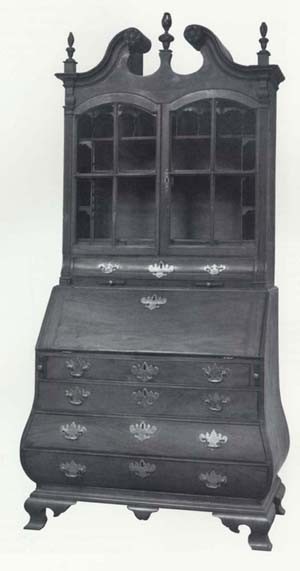
Desk-and-bookcase, Boston, 1770–1788. Mahogany with white pine. H. 97", W. 46 3/4", D. 23 3/4". (Courtesy, Springfield Science Museum, gift of Edward A. Andrews.)
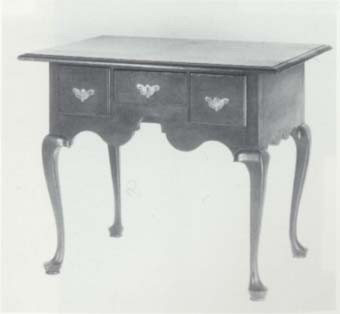
Dressing table, Wethersfield, Connecticut, 1745–1760. Sycamore with white pine. H. 27 1/2", W. 33 1/2", D. 23 1/2". (Courtesy, The Connecticut Historical Society, Hartford, Connecticut; gift of George Dudley Seymour.)

High chest of drawers attributed to Eliphalet Chapin and/or Aaron Chapin, East Windsor, Connecticut, ca. 1785. Cherry with white pine. H. 87 1/8", W. 40 1/4", D. 20 1/4". (Courtesy, Winterthur Museum.)
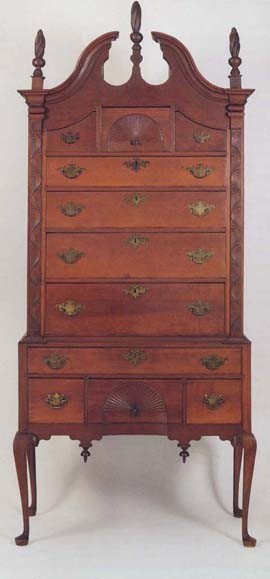
High chest of drawers attributed to Eliakim Smith, Hadley, Massachusetts, ca. 1770. Cherry with white pine. H. 89 3/4", W. 39 15/16", D. 20 3/8". (Courtesy, Historic Deerfield, Inc.; photo, Amanda Merullo.) www.historic-deerfield.org

Side chair, East Windsor area, Connecticut, 1770–1790. Cherry and ash. H. 42", W. 19 3/8", D. 13 7/8". (Private collection; photo, John Giamatteo.)
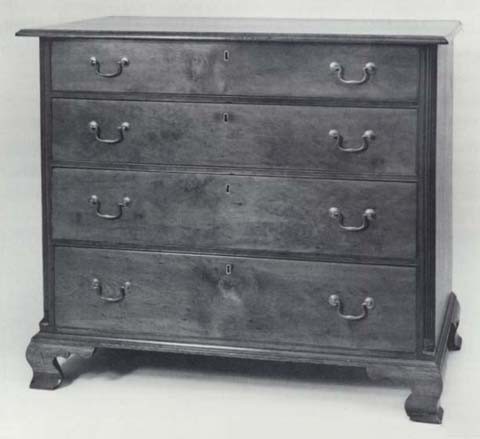
Chest of drawers made by Thomas Bliss and John W. Horswill, Charlestown, New Hampshire, 1798. Cherry with white pine. H. 35", W. 41 1/8", D. 21". (Private collection.)
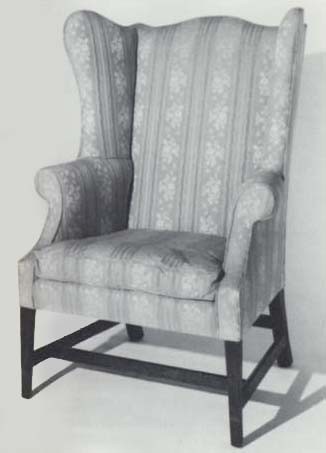
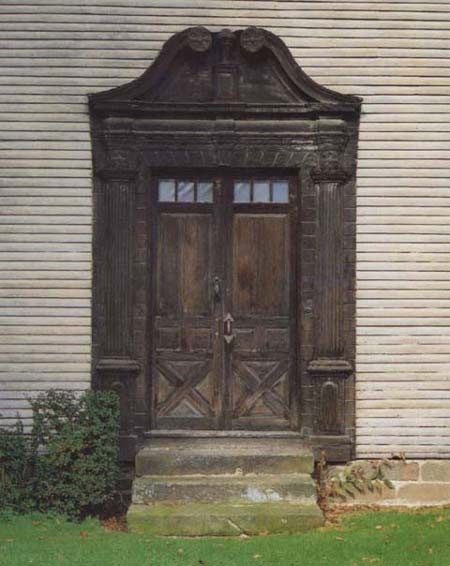
Doorway, probably made by Samuel Partridge (1730–1809) for Elijah Williams, Deerfield, Massachusetts, 1760. White pine. (Photo, Amanda Merullo).
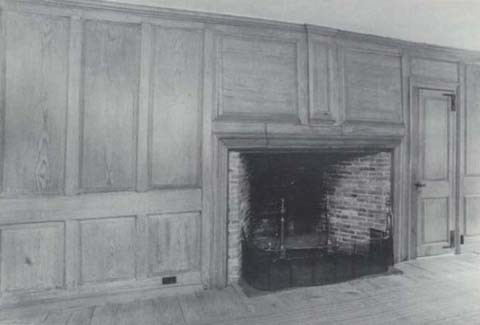
Chimneypiece (ca. 1760) in the south parlor, Sheldon-Hawks house, Deerfield, Massachusetts, ca. 1735. White pine. (Courtesy, Historic Deerfield, Inc.; photo, Amanda Merullo.) www.historic-deerfield.org
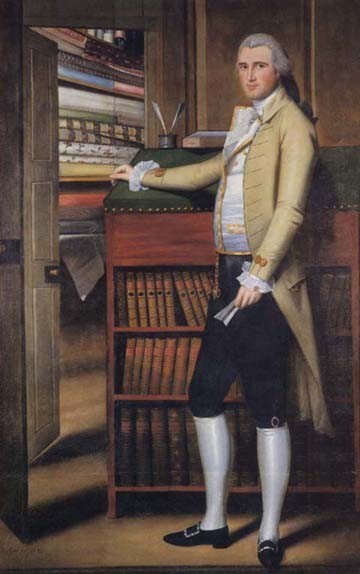
Ralph Earl, Elijah Boardman, New Milford, Connecticut, 1789. Oil on canvas. 83" x 51". (Courtesy, The Metropolitan Museum of Art, Bequest of Susan W. Tyler, acc. 1979.395) All rights reserved, The Metropolitan Museum of Art.
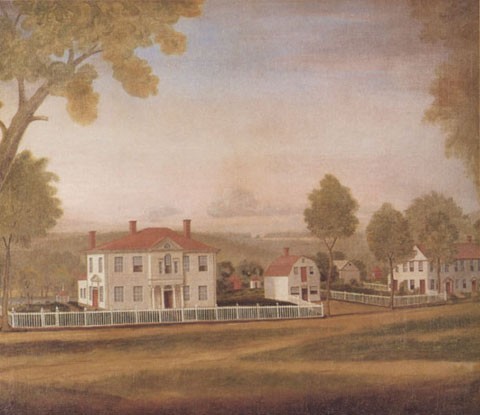
Ralph Earl, House and Store of Elijah Boardman, New Milford, Connecticut, ca. 1796. Oil on canvas. 48" x 54 1/4". (Courtesy, Wadsworth Atheneum.)
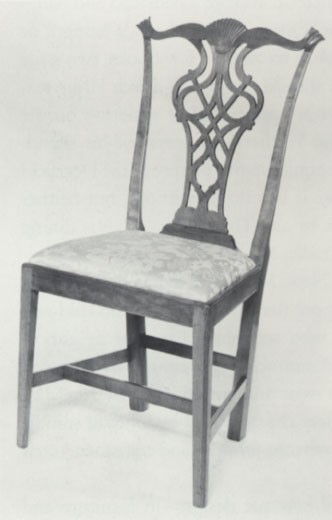
Side chair attributed to the Chapin workshops, Hartford County, Connecticut, ca. 1800. Cherry with white pine. H. 38 1/2", W. 19 1/2", D. 15". (Courtesy, Historic Deerfield, Inc.; photo, Helga Studio.) www.historic-deerfield.org
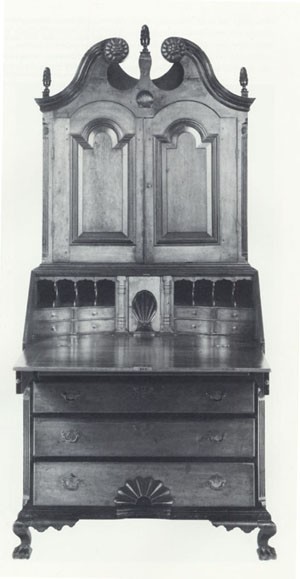
Desk-and-bookcase, Woodbury, Connecticut, 1770–1800. Cherry with white pine. H. 96", W. 40", D. 21 5/8". (Courtesy, Winterthur Museum.)
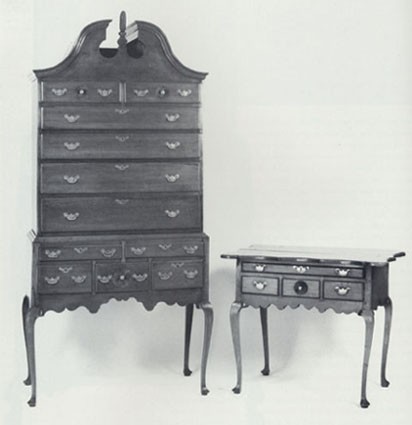
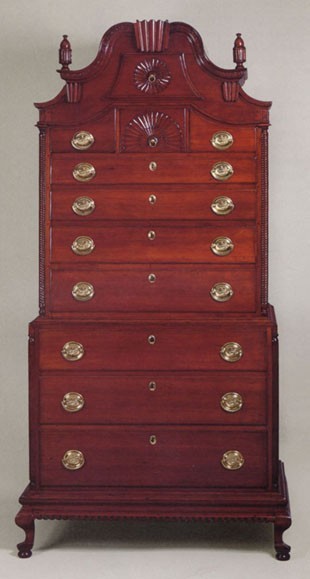
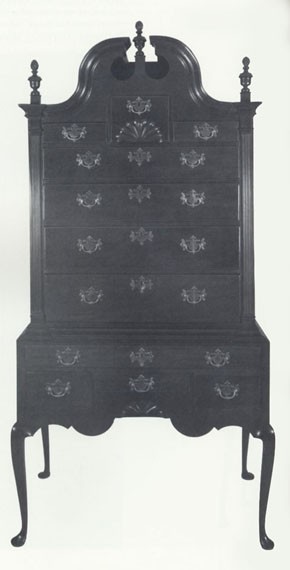

Desk-on-frame, southern Hartford County, Connecticut, ca. 1785. Mahogany with white pine and yellow poplar. H. 44", W. 40", D. 21". (Courtesy, Yale University Art Gallery, gift of C. Sanford Bull, B.A. 1893)
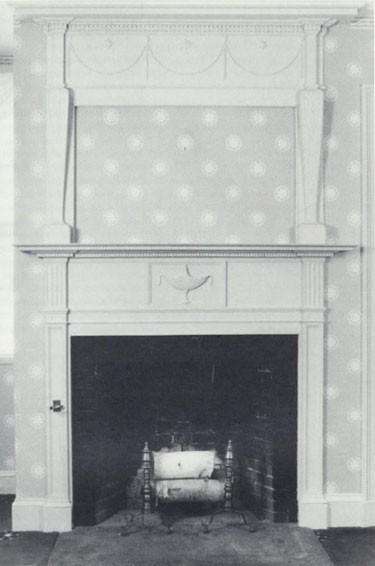
Chimney breast made by Joseph Griswald, Buckland, Massachusetts, 1818. White pine. (Photo, Amanda Merullo.)
This essay explores diversity in the marketplace by examining New England furniture as an extension of rural culture, economy, technique, and design. Generations ago, rural style did not evolve in a vacuum.[1] Diversity was a fact of life. Household objects came from near and far and were always the products of personal attitudes about the right way to build something based on training and cultural preference. Today, choice is an illusion in the marketplace. The car bought in California is like the one purchased in Vermont. This homogeneity of material culture results from specialized labor and from interchangeable parts stocked on endless shelves. The product itself plays second fiddle to market share, labor cost, and corporate monopoly. Some will lament the loss of old-time standards of quality or distinctiveness, while others thrive on change. In either case, the modern manufacture and use of goods has created false assumptions about the context of objects created years ago.
Mapping provincial design is more complicated than simply drawing dissemination on the model of a wagon wheel. The original concept may well reside at the urban hub, with consumers and their ideas ranged along the spokes. The vernacular, nonacademic, naive furnishings are then usually placed at the distant rim. But the perception of distance to a point and its relevance depends upon location. If you are living well at the rim, the hub seems vague, superfluous, and distant. Furthermore, the end of each spoke is linked to other spokes by the rim, giving another avenue for the exchange of ideas and for strengthening cultural expression.
The nature of New England cabinetwork is clarified by acknowledging modern perceptions of antique furniture and by coupling them with valid hypotheses about rural society. We must recognize that the upland towns, while distant, were not isolated, and that craftsmen were businessmen eager to expand their patronage in order to make a living. Despite die-hard assumptions about isolation and homogeneity, these conditions were not uniform throughout the land. Most American subcultures were neither isolated nor homogeneous in their tastes. Separate traditions coexisted. Although the basic elements of language, law, government, economics, land use, religion, and family structure were shared, personal belongings usually demonstrate cultural pluralism. Trade was valley oriented and could not have flourished in isolation. Fashion rode easily on the back of commerce.
If the theory of isolated regionalism is tossed aside, the usual questions become more complex. Does rural design reflect only ignorance and eccentricity? Does it confound classification and analysis? How can objects so provincial have been high style and expensive? What was the impact of a confidence born from a prosperous agricultural economy on the selection of ornament and the creation of form in rural cabinet shops?
Although a lot of good design was fashioned in the countryside, as elsewhere, inventiveness is often tagged as eccentric and confused with ignorance. The “folksy” flowering of native motifs never grew in isolation nor without inspiration. Wonderful hybrids of design created in “the back of beyond” document the cosmopolitan influences that shaped rural culture and the expectations of its people (fig. 1). Other furniture made simultaneously nearby (fig. 2) is devoid of ornament and illustrates the “neat and plain.” Although the absence of ornament may seem an odd statement of popular design (and a good excuse for saving the expense of hiring specialists), the clean appearance of some eighteenth-century furniture was purposeful, with deep roots in Enlightenment thinking. As noted by John Witherspoon (1723–1794), president of the College of New Jersey: “It may also appear from . . . those compositions which have most simplicity and such excellencies as are most solid, with fewest of the casual ornaments of fashion. . . . The same thing holds with pieces of furniture that are elegant but plain.”[2]
The American romance with independence has created a place for regionalism in the national ethos. The passage of time and improvements in technology and transportation have resulted in a selective memory that fuels clichés about rural isolation, regional distinction, and simpler times.[3] Consequently, furniture with heavy doses of imitation or innovation is invariably defined according to rural stereotypes and to economic conditions assumed to be prevalent at distant points. We like to think of brigadoons safe from the homogenization of culture. These sanctuaries are usually fortified, in the mind’s eye, by mountains or water and are places like Vermont, the Smokies, the Bayou country, New Mexico, the Rockies, and Quebec Province. They are often places with distinctive food, or at least beer, and some of them are ethnically distinct, or used to be. In these places, regionalism may exist, if a little contrived, through the sheer vigor of myth and marketing.
Vermont is a good example. Despite the myth of isolation, at least four distinct types of furniture were made there before 1840.[4] First was generic, eighteenth-century-style furniture, some made after the year 1800. It is invariably misattributed to elsewhere in New England, because that is where first-generation Vermont artisans learned their trade (fig. 3). Next, some wealthy patrons developed an appetite for stylish furniture that hybridized urban styles made in the large seaports along the New England coast and in New York City (fig. 4). A third and cheaper type of furniture was made fashionable by ornamental paint that imitates and exaggerates expensive materials (fig. 5). This furniture is associated with Vermont but was often factory made, especially chairs. Last, generic, high-style furniture of imported designs and materials indistinguishable from elsewhere in the Northeast was available to patrons of small factories (fig. 6).
Creation and consumption are seldom strictly local phenomena, at least in rural furniture. A healthy economy is built on openness and assimilation, not isolation and independence. Some of the most notable “regional” furniture is the product of a single, dominant craft tradition with links far beyond local boundaries. The Gaines family of turners in coastal Ipswich, Massachusetts—John II (1677–1748) and Thomas I (1712–1761)—emulated popular Boston designs when making thousands of chairs, far more than their neighbors could use (fig. 7).[5] The Gaineses shipped these chairs in the coastal trade. Volume permitted them to perfect their skills, designs, and production methods and to create a memorable form mistakenly regarded as a local rather than as a commercial and cosmopolitan occurrence.
Sometimes, rural craftsmanship is so true to urban prototypes that its design, proportion, and materials lead to confusion with coastal cabinetwork, like the furniture of Alden Spooner (1784–1877) of Athol in western Massachusetts (fig. 8). Other times, clear urban antecedents were adapted to local conditions. Michael Carleton (1793–1876) made the sideboard illustrated in figure 9 at Haverhill, New Hampshire, using templates for a chest of drawers. Apparently built for a patron with a small house, the half sideboard (the period term) incorporates the trappings of modern design with the astragal corners and drop panel popular in Portsmouth, a hundred miles away. Himself a native of the lower Merrimack Valley, Carleton provided his customers with current, coastal styles.[6]
Later in the nineteenth century, manufacturing accelerated the homogenization of furniture design throughout New England. Divergent forms could be made quickly under the same roof in order to expand business through the offer of one-stop shopping. In western New Hampshire in about 1830, Willard Harris (1782–1848) of Newport employed up to fifteen workers, including Horace Ellis (b. 1807) and Martin Bullock (1810–1876), and simultaneously sold fashionable mahogany Empire bureaus and fancy painted dressing tables, signed by these craftsmen (figs. 10, 11).[7]
From childhood, we are trained to categorize things by their appearance. Consequently, the questions often heard in the analysis of artifacts are: What characterizes the object? And, what characteristics are shared with other objects? Many people scrutinize antiques by “regional characteristics,” which help to organize visual information, like arranging books alphabetically or by subject matter. The irony is that “regional characteristics” paint an incomplete picture of regional life and the conditions reflected in people’s possessions. The evolution of distinctive regional traits, and the reasons behind them, vary dramatically over time. The quality of life in a first-generation, seventeenth-century town was quite different in 1850. Furthermore, so-called style regions usually supported several craftsmen working in the same medium. They might make different styles to suit the pocketbook or cultural preferences of various buyers in the American melting pot. Indeed, the purchaser controls economic exchange and determines the appearance or style of artifacts. If the customer cannot or will not pay for it, no craftsman is foolish enough to make it.
The relationships exposed by categorization are important, but they do not tackle the most essential question in the study of three-dimensional, material culture: Why do things look as they do? We can examine history through the study of material culture if we learn its language.[8] Artifacts or antiques, depending on your viewpoint, inspire speculation about what life was like at a given point in time. Consequently, they are sources of ideas and information when closely read. The conditions of life, just like the characteristics of a chair or chest, are rarely beautiful, but they are invariably revealing if one moves beyond the patina of age or the scars of use. Although this approach may seem too history based for some connoisseurs, studying the environment and economy invested in the appearance of each wonderful thing leads to understanding artifacts better.
Although teacups and tables force us by their inanimate nature to ask what they are, we are most interested in who stood behind them as makers and owners. This is where the romance and sinew of history lie. It is the human condition surrounding the object that holds the most relevant information. After the physical characteristics of the bureau illustrated in figure 12 are defined, the real question jumps out: Why did the owner commission, and the craftsman make, this large cherry and yellow poplar chest, inlaid with an inscribed marble family register? We can only hypothesize about the conditions that led to its manufacture, the merger of skills involved, and the strong statement of ownership and commemoration. Although the exact reasons are lost, few Anglo-American items bear such a totem-like presence.
Some objects offer clear proofs in the historical analysis of a time and place. Their vocabulary, although unspoken, can be quite detailed. Westfield, Massachusetts, cabinetmaker Erastus Grant (1774–1865) signed the serpentine chest of drawers illustrated in figure 13 on October 11 and November 2, 1799. The date range says something about the time spent in constructing such a chest. Grant used new-fangled, cut nails to fasten the drawer bottoms and backboards, which tells us that the economy and technology surrounding nail production had modernized in western Massachusetts before the autumn of 1799. Simultaneously, Grant’s addition of an inlaid patera on the top and quarter-round fans on the drawer facades makes this chest the earliest documented piece of furniture with neoclassical detail made in western Massachusetts. His use of a dustboard between the second and third drawers is similar to the workmanship of Eliphalet (1741–1807) and Aaron Chapin (1753–1838), with whom he probably trained in Hartford, Connecticut. This construction detail is common on Philadelphia case furniture and may have been learned by Eliphalet when he worked there as a journeyman between 1767 and 1771.[9]
The analysis of objects is improved by grappling with them on their terms and by discarding as many modern preconceptions and conditions of our own culture as possible. One example is the search for folk art in the texture and ornament applied by anonymous people to simple, useful objects. Art-by-guess-and-by-gosh is rarely simple. A grain-painted chest or clock case executed by a specialized ornamental painter to simulate more costly materials entails complex expectations and procedures. As for the simple way of life, an object like a milk stool is only rudimentary until you try to make one. The concept of folk art as a catch-all category for certain nonacademic styles dates from the 1920s and is important in understanding twentieth-century aesthetics, but it has little to do with nineteenth- or eighteenth-century life or perceptions of world view.[10]
Another obvious example is the nagging and virtually meaningless distinction between city and country furniture. This categorization is important to us as late-twentieth-century people, who live in an urbanized society. We face the problems and expense of urban decay as well as the joys that a few hundred dollars can bring to an evening on the town. But what did city versus country mean to American society before 1920 when more people lived on the farm than in suburbia? Their possessions tell a different story. For example, we recognize mahogany as an expensive, imported wood widely used in urban furniture after the mid-eighteenth century, and we usually define Connecticut cabinetwork as rural. Yet some eighteenth-century Connecticut furniture is made of mahogany, breaking down two sets of suppositions about early craftsmanship (see figs. 47, 48).[11]
Several other misconceptions cloud our perspective on objects and limit our enjoyment and understanding of old things. As a culture of consumers, we are continually distracted by visual quality and the connotations of status in objects. For example, clocks were one of the leading status symbols in eighteenth-century households. But the clock cases made by the Dunlap family in southern New Hampshire are invariably cited as squat, bizarre attempts at craftsmanship, although expensive ones (fig. 14). Some might ask, “Why did they waste their money?” In this instance, Major John Dunlap (1746–1792) obviously did not draw on the comfortable proportions of a classical column for the clock case, as was usually done, but neither did he reject architectural precedent. His case is designed like a pedimented frontispiece or doorway based on the academic correlations recommended by William Salmon in Palladio Londinensis (1734).[12]
Design aside, we have a tendency to value the physical qualities of the object over the complexity of the craftsman’s ideas, materials, and the context in which he worked. Benjamin Cheney, Jr. (1725–1815) and Timothy Cheney (1731–1795) began making clocks in East Hartford, Connecticut, about 1750 (fig. 15).[13] Perhaps because their father was a joiner, they developed the concept of offering options in clocks to expand their clientele: thirty-hour wooden movements as well as more expensive, eight-day, brass clocks. From across the parlor, both products look essentially the same. Upon close inspection, the depth of the hood concealing the wooden movement is much deeper to accommodate its cumbersome parts (fig. 16). Some dials even have false painted winding holes to complete the deception of an eight-day clock. The thirty-hour version is wound by pulling up the weights on the rope behind the waist door. The cases of the economy model are often made of native pine (though hardwood examples are also known) stained to imitate mahogany or cherry. Two centuries later, these clocks are usually rejected by collectors on the basis of quality, although the ingenious wooden mechanism and the marketing concept behind it were among the more sophisticated ideas afoot in the marketplace of eighteenth-century New England.
Likewise, we also tend to value the quality of ornament over the quality of construction, the sole province of the craftsman, who might select one method over another for reasons of structural integrity or the availability of materials. The chest illustrated in figure 17 has ornamental paint to simulate inlay and stringing, but its most costly, labor-intensive feature is against the wall. The backboards are dovetailed to the case sides rather than simply nailed into a rabbet or beveled to fit into a groove.
Similarly, simple but highly functional objects are rarely appreciated unless they are Shaker made. The curious pine shelving illustrated in figure 18 is actually the product of clever design. Made to butt up against the long side of a table, it is lightweight and mobile and is intended to create a desk complete with a central “prospect” and space for storing ledgers and papers. The decisions resulting from the need for a mobile desk led to distinctive workmanship.
Quality obtained from efficient production is invariably overlooked. Plans of some sort were always used to create design. Specified measurements or the replication of shapes assisted by templates made craftsmen more efficient and faster. These plans could be quite detailed; other times, notes were sketched on the back of a board long since used for kindling. In either case, the replication of form is an under-used clue in identifying shop traditions and methods, except perhaps in the connoisseurship of pewter made in long-lost molds. For example, a secretary made in William Lloyd’s (1779–1845) shop at Springfield, Massachusetts, in 1804 has a writing surface and base adapted from existing templates for a card table (fig. 19).[14]
Obviously, multiple objects from a shop tradition like Lloyd’s go far in defining the range of workmanship practiced by established craftsmen. Nevertheless, we invariably define skill or quality on the basis of a single surviving object or type of object. Windsor chairmaker Stephen Tracy (1782–1865) of Lisbon, Connecticut, and Cornish, New Hampshire, is a good example. He was the nephew and probable apprentice of Colonel Ebenezer Tracy (1744–1803) of Lisbon, a highly skilled specialist who is the most famous of all Windsor chairmakers. Hundreds of chairs by the Tracys and their apprentices have survived, and the assumption might be that they only made chairs. Although seating furniture dominated, Stephen’s ledger shows that he also made agricultural implements and case furniture, including the fashionable bow-front bureau perhaps built for Erastus Adams in 1806 (fig. 20).[15]
There is also a strong tendency to overlook historical reality. The Shakers, for example, are renown for the clean, efficient designs of their furniture. The sect is especially well known for chairs, which they made in quantity for “the world.” Today, anything with crisp lines is defined as Shaker. The chair illustrated in figure 21 was factory made in the Renaissance revival taste about 1890 at the Shaker community in Canterbury, New Hampshire.[16] The clue to its origins are the tilters on the rear legs to make leaning backwards less damaging to the floor. At face value, this chair is the last one to fulfill the dreams of a traditional collector of Shaker furniture.
Just as we might focus on a single object to define the range of one man’s work over several years and perhaps in several places, we also regularly fix on the moment of creation as the only significant point in the history of an artifact. However, possessions move through time and are affected by the environment and changing perceptions of their beauty or usefulness. Frequently, a significant component of an item is swept away during restoration because it was not part of the original craftsman’s or owner’s intent. The loss of paint layers is a good illustration, but structural details that say a great deal about modernization are also often lost to “repair.” What was once a common upgrading of design can become quite rare because most examples have been restored to their original appearance. The chair illustrated in figure 22 was made originally for Governor Caleb Strong (1745–1819) of Northampton, Massachusetts, about 1780. His children or grandchildren came along in the 1820s or 1830s and thought it should have modern scrolled arms to make it appear less old-fashioned, so a craftsman arguably as competent in neoclassical design as the original maker in the style of his period was hired to do the work.
Style is rooted in the desire to associate with people of power, wealth, or intelligence. When emulation accelerates, fashion becomes hybridized and usually reinvented at lower price levels. In the eighteenth century, this process took less time than we think. Although the products of hybridization may appear ungainly, the effect was quite modern. For example, the Windsor, Connecticut high chest of drawers illustrated in figure 23 is dated “1736,” only six years after the documented appearance of the cabriole leg in Boston, and it may not have been the first made by this anonymous craftsman. He used the latest techniques to construct the upper case—dovetails rather than mortise-and-tenon joinery—and gave the cabriole legs bold curves that anticipate William Hogarth’s line of beauty, published a generation later. The cabinetmaker, or a local painter-stainer, also ornamented the chest with paint that simulates contemporary Boston “japanning.”[17]
The diversity within and the interaction between regions make it clear that defining a place through one object (or vice versa) is a false step in determining a distinctive lifestyle. Multiple objects from a single shop paint a clearer picture of regional relationships and aspirations. For example, the previous high chest of drawers and the dressing table illustrated in figure 24 were made in the same anonymous shop but were ornamented differently. We know that urban patrons often specified furniture with fine walnut veneers, and some householders in Connecticut had similar aspirations. In concept, the cabinetmaker offered a dressing table with a veneer of paint to simulate the imported wood.
Demand for stylish furnishings created new designs in rural New England, sometimes regardless of the availability of goods in nearby urban commercial centers. The small city of Portsmouth, New Hampshire, for example, did not support successful clockmakers until after the Revolution because the elite imported English or Boston tall clocks. In the country towns nearby, wealthy farmers were unable to acquire these status symbols. Not to be outdone, they patronized blacksmiths, especially in the towns of Kensington and Kingston, who demonstrated a genius for making iron posted-frame clocks that ran for a day in cases inspired by late-seventeenth-century English designs (fig. 25).[18]
Sometimes the broad appeal of certain motifs broke down the presumed boundaries of regions and even technologies to become universal. The flared ears on rococo chairs, for example, were standard fare throughout the eastern seaboard. A group of turners in the Piscataqua region of coastal New Hampshire found an imaginative way to build the same motif into their chair design, even though their lathes limited turning to straight rather than curvilinear parts (fig. 26).[19] Although the finials were destined to remain strictly vertical, these turners made crest rails with flaring ears that assume the appearance of paired fish tails.
The diversity found in objects goes beyond personal or eccentric preference, and the borders of culture, however fluctuating, are defined by more than time and place. Ethnic identity provides distinctions within the mixed culture of a place. For example, threads of Old World material culture and technique were carried by the Scots-Irish to southern New Hampshire and certainly by the Germans to Pennsylvania. These craftsmen made furniture alongside English joiners and were similarly linked to their own cultures by design and technique. John and Samuel Dunlap (1752–1830) in New Hampshire, for example, were trained to make distinctive furniture derived from Scots-Irish designs popular a century and a half earlier (fig. 27). Similarly, Norwich, Vermont, cabinetmaker George Stedman (b. 1795) offered local clientele (and presumably consumers in his hometown of Chester) the option of cherry furniture inspired, not by English, but by French Louis XVI designs (fig. 28).[20]
The diverse character of rural New England furniture is well rooted in the seventeenth century when society was completely fragmented by the mobility and varying traditions of people from all around Great Britain. At least seven joiners whose divergent origins are known worked in Windsor, Connecticut, during the first generation of settlement. Faced with a vast forest of numerous species of trees, each with special woodworking advantages, they chose to work with oak, the traditional wood of English joinery, and to ornament their furniture in the way that they were trained. One shop made chests built entirely of riven oak in the manner of Gloucestershire work in the west of England (fig. 29).[21]
Ironically, only stagnation encouraged homogeneous design at the regional level. Hadley chests, first made in western Massachusetts at the end of the seventeenth century, constitute the largest group of joined furniture in America; some 250 chests, tables, boxes, and fragments are recorded (fig. 30). The study of these chests by Clair Franklin Luther in The Hadley Chest (1935) confirmed the concept of regionalism early in the literature of American antiques. Unfortunately, he had investigated one of the few exceptions to regional diversity in American material culture. Hadley chests were made throughout the Connecticut River towns of western Massachusetts until about 1740 by generations of joiners working in an isolated economy of oligarchy and indebtedness to one family: the Pynchons of Springfield. The members of this founding family patronized specific joiners for both private and public works throughout the towns that they subsidized. The result was the homogenization of design and construction for three or four generations.[22]
Restyling came slowly to Hadley chests. Although the technical preferences for internal construction remained intact, western Massachusetts joiners finally began to emulate fashionable coastal styles in the baroque taste. The joined chest of drawers in figure 31 looks like the upper case of a walnut-veneered high chest made by a cabinetmaker a hundred miles away in Boston. The tradition of consistency was broken after the conclusion of raids by the French and Indians about 1745 and after the emergence of new wealth among related families of patrons, called the “River Gods.”[23] They sought fashionable goods and supported native cabinetmakers. It was the eager patron, not the efficient craftsman comfortable with replication, who made the decision to alter the tried and true.
Understanding the willingness to change underscores the importance of the “who” rather than the “what” in objects. Patronage by people of varying economic status or cultural bias, superimposed on one another in their respective towns, created diverse and often contradictory regional expressions. With time, the material culture of the gentry network in each locale came to dominate what is remembered because of the power of status, money, and quality. These things became the expression of an age, but they may not have been totally representative of it.
In this context, the craftsman and the patron were joined by the merchant, who brokered the appearance of fashion and who factored an array of foreign goods into the local economy. With their extensive connections, these people made outlandish objects available through knowledge and the growth of capital. For example, within two years of settlement on the New Hampshire Grants in the mid-1760s, merchant Jonathan Chase (1732–1800) of Cornish was bartering mohair, silk, chocolate, and knee buckles with neighbors eager to put aside the frontier and to enjoy their investments. Down the Connecticut River, a half century after Hadley chests had dominated the parlors of western Massachusetts, Springfield’s minister, Reverend Bezaleel Howard (1753–1837), owned a costly and cosmopolitan Boston bombé desk-and-bookcase that undoubtedly became a local standard for acceptable fashion (fig. 32).[24]
The scholarship on regionalism in the eighteenth century is especially muddled. An inordinate amount of rural furniture is attributed to either Connecticut or New Hampshire just because it looks like it. But where are the belongings of the people in Vermont, western Massachusetts, the District of Maine, and upstate New York? In southern New Hampshire and Connecticut, there was a broad middle class quick to emulate the taste of wealthy neighbors. These agricultural societies were prosperous and had choices. But today, only the dominant craft traditions, typically involving multi-pandered to the elite, and the sheer volume of surviving furniture testifies to their marketing strategies.
The most dominant craftsmen responsible for “regional styles” often had pan-regional, coastal ties. In Connecticut, William Manley (ca. 1703–1787) of Wethersfield, who probably introduced the cabriole style of cabinetwork to the Connecticut Valley, moved from Charlestown, near Boston, in 1729 (fig. 33). Benjamin Burnham (1737[?]–after 1773) of Colchester and Eliphalet Chapin of East Windsor Hill both worked in Philadelphia during the 1760s. Chapin’s fashionable Delaware Valley–style furniture was the rage in central Connecticut and parts of western Massachusetts for a generation, making it an unlikely illustration of regionalism (fig. 34). The furniture attributed to Eliakim Smith (1735–1775) of Hadley, Massachusetts, was made with Boston proportions and construction details (fig. 35). In southern New Hampshire, the Dunlap family of cabinetmakers were both pan-regional and pan-cultural. They rejected nearby Anglo-Boston styles for the motifs derived from the Scottish Lowlands 150 years earlier (see figs. 14, 27).[25]
Hundreds of objects survive by these famous Connecticut and New Hampshire craftsmen. The strength of tradition demonstrates the buying power of patrons more than the independence of craftsmen whose work was a commodity instead of decorative art. An extreme case is the relationship of cabinetmaker John Dunlap with the local sawyer, Job Dow, who apparently had enough capital to act as a furniture broker. He sold thousands of board feet of hardwood and pine to Dunlap in the years before the Revolution. In return, the cabinetmaker built forty-six pieces of furniture for the sawyer between 1769 and 1784 to settle the account, far more than Dow could use at home.[26] The sawyer probably bartered some of the furniture on his own account, in a way competing with the cabinetmaker.
On the other side of the coin, the furniture made by the “little guys” who enjoyed limited patronage now seems either innovative or bizarre, depending upon your perspective. More business might have brought efficiency and fame to their designs. Instead, they fit nicely into our misconception about the work of naive or independent craftsmen. Their products appear awkward next to the furniture of the pan-regional craftsmen, who operated large shops. For example, a chair made in the vicinity of Windsor, not far from Chapin’s shop at East Windsor Hill, may seem odd, but it was expensive to produce, with a “crookt back,” carved crest rail, and pad feet (fig. 36).[27] The chair incorporates many fashionable details from the vocabulary of pan-regional design, exemplified by its Chinese pagoda-like crest rail and rococo ears. Clearly, its maker was not ignorant of convention.
Such hybrids show the mistake in defining furniture by style alone based on a “chronology” of designs loosely associated with the reigns of kings or with cabinetmakers who published design books, such as Thomas Chippendale and George Hepplewhite. Although these names, no matter how accurate or appropriate, can be useful in learning this material, the assumption that styles are monolithic and sequential is false. Many styles were offered simultaneously, like the work of Thomas Bliss (1767–1839) and John W. Horswill of Charlestown, New Hampshire, who produced both rococo and neoclassical furniture during their brief partnership between December 1797 and March 1798 (figs. 37, 38).[28]
Chippendale is an especially poor term for rococo furniture made in rural New England between about 1760 and 1810. This style encompasses the Chinese, Gothic, and “modern” (or French) tastes, yet little furniture made outside of Boston, Salem, and Portsmouth bears the hallmarks of “Chippendale” design: claw-and-ball feet, cabriole legs, and foliate carving that is often asymmetrical. These details are scarce in rural New England, dominated by the “neat and plain,” because such ornament was the work of specialists whose products may have seemed foreign, vulgar, or unnecessary in the conservative households of the Yankee upland. In truth, Thomas Chippendale (1718–1779) and his Gentleman and Cabinetmaker’s Director (1754) were virtually unknown in New England in those days. Although a few urban objects were inspired by plates in the Director or by imports based on those plates, the book was not owned anywhere in rural New England.[29]
Most rural design, refined or experimental, was governed by a provincial aesthetic that permeated New England through most of the eighteenth century. This style is organized, rational, and even predictable in its attenuation, verticality, symmetry, and pretension. It is essentially baroque in its balance, formality, and vertical stance. Like the chair from Windsor, some vocabulary of stylish urban work is usually present, but it is exaggerated.
There is little doubt that a provincial baroque aesthetic governed the constructed surroundings of rural New Englanders throughout most of the eighteenth century. When Major Elijah Williams (1712–1771) built a new house in Deerfield, Massachusetts, with a modern doorway in 1760, he offered passers-by a strong impression of baroque formality.[30] The scrolled doorway emphasizes the axis of the large central-hallway house with ornamental moldings and burgeoning S-curves (fig. 39). A kind of carpenter’s baroque easily fashioned from elaborate moldings was perfect for rural patrons drawn to conspicuous consumption. Imaginative and exuberant options were fashioned from standard moldings and fielded panels to achieve a bold, complex, and sculptural overstatement (fig. 40).
To understand baroque design as it was reinterpreted in the New England hinterland between 1720 and 1820, we must turn to the domestic context and conditions that shaped the selection of form and ornament. The designs preferred by this distant but unisolated society were determined by several factors: European precedent, shifting political allegiances and trade connections, agricultural wealth, mobile networks of family members and apprentices, a lack of craft specialization due to labor demands, and the desire for speedy replication of form in order to make a living. Although baroque design for Yankee consumers had its roots in the visual traditions of the courts of William and Mary and Queen Anne—formal, bold, symmetrical, vertical, and vigorous—it was refashioned by the pressures of a prosperous agricultural society made conservative by the rigid annual cycle of farm work and by a lack of specie in a barter economy. Style was also tempered by rote learning and face-to-face relationships. Furniture was local and custom-fit to neighborly expectations and to local architecture. Nevertheless, these Yankees were not out of touch. Only their furniture, utilitarian ceramics, and most of their iron were manufactured at home. The remaining consumer goods enjoyed in rural New England were foreign imports.[31]
Agriculture provided substantial purchasing power in the fertile valleys of New England. Prosperity sprang from supplying provisions during the Seven Years War in the 1750s and later during the Revolution. Farming was specialized, and cash crops were raised for export. Individual towns became identified with single commodities by the middle of the eighteenth century. In Connecticut, Wethersfield was known for its onions, East Hartford and Glastonbury for tobacco, Windsor for horses and flaxseed. Enfield and Suffield shared their reputation for wheat with Longmeadow and Northampton in western Massachusetts. Farther up the Connecticut Valley, farmer-merchants in Deerfield, Hadley, and Hatfield drove fattened beef to Boston. In western New Hampshire and Vermont, lumber was harvested, especially the tall white pines. In southern New Hampshire, the Scots-Irish had a reputation for their linen.[32]
Much of the population in the rich valley towns lived in big houses on farms. Tax lists show that two-story houses greatly outnumbered one-story houses in Wethersfield in 1773. John Adams (1735–1826) described this prosperous scene on June 8, 1771, when he rode south from Windsor through Hartford to Wethersfield:
I had spent this Morning in Riding Thro Paradise. My Eyes never behold so fine a Country. From Bissells [tavern] in Windsor to Hartford Ferry, 8 Miles, is one continued Street—Houses all along, and a vast Prospect of level Country on each Hand, the Land’s very Rich and the Husbandry pretty good. Here is the finest Ride in America. . . . I wish Connecticut River flowed through Braintree [his home on the south shore of Massachusetts].[33]
The wealth of these New England valleys supported ambitious architecture and furnishings, although the houses were sometimes grander than the people. The interior rooms are often nicely paneled but small and multi-functional. The typical Deerfield parlor in 1775, for example, was sparsely furnished by our standards. It contained on average a bedstead and hangings, six crooked-back (late baroque or “Queen Anne”) chairs, a “round” or oval drop-leaf table, andirons, fire tools, a trammel, a few books, two wine glasses, two punch bowls, white tea dishes, and a half-dozen silver teaspoons. Although probate inventories are not complete windows on the past, John Adams’s description of the Wethersfield house of his friend, Doctor Eliot Rawson, substantiates the quantitative picture of the Deerfield parlor seventy miles away: “His house is handsome without, but neither clean nor elegant within, in furniture or any Thing else. . . . His dining Room is crowded with a Bed and a Cradle, &c. &c.”[34]
Elijah Boardman (1760–1823) of New Milford, Connecticut, in the Housatonic Valley was among the upper tier of merchants who sold raw materials for finished products and who set trends for their neighbors (fig. 41). He represents a phalanx of consumers eager for the trappings of status, which he readily traded at his store and counting house (fig. 42). Such country people moved in a society characterized by a broad middle class, who combined livelihoods as merchants, farmers, and craftsmen, often on a seasonal basis.[35]
The governing convention of rural baroque design—in furniture and portraiture (see fig. 41)—is a vertical emphasis achieved by exaggeration and attenuation. This exaggeration disrupts the whole design but emphasizes its parts to the point where they almost exceed the whole, like the fins on Detroit’s automobiles in the 1950s that were meant to emphasize size and movement and to identify cars with airplanes. Boardman becomes an abstracted expression of himself, bigger than life with those long limbs and torso in a picture 83” tall.
In furniture, the emphasis on the parts highlights the stylishness of the object, often flagrantly, in the same way that paint color (which these people also used extensively) is used to emphasize detail (fig. 43). The attenuated, usually vertical, eighteenth-century shapes work to good visual advantage in the small, paneled parlors and chambers of rural New England, partly because the furniture for these homes was often made by the same craftsmen during the winter months.[36] In many instances the furniture probably appeared larger owing to the sparse furnishings and low ceilings of most middle-class houses. The western Connecticut desk-and-bookcase shown in figure 44 illustrates the point. The paneled doors and “scroll’d head” give it a strong architectural presence enhanced by familiar baroque ornaments such as the large shell at the base. Unconventional design was an intentional vehicle of stylishness rather than a symptom of ignorance.
Options in exaggerated moldings and S-curves were available to rural furniture buyers throughout this period. Probably made about 1765, the high chest and dressing table illustrated in figure 45 became a rhythmic staccato of S-curves and brass hardware. The complex, scalloped top of the dressing table was the high-style choice for tables and chests, which the cabinetmaker otherwise simply fitted with rectangular tops. The scalloped option in Connecticut Valley furniture, made first in Wethersfield and then northward in Northampton, Hatfield, and Deerfield, is visually exciting, but it constitutes a kind of abstract baroque. The sawn shape is ultimately two-dimensional, reducing the cost of detailed, free-hand carving, although it aspires to more. A generation later, the old baroque formality was still preferred in hill towns like Conway, Massachusetts, where Jonathan Smith Jr. (b. 1770) made a doorway-like chest-on-chest in 1803 (fig. 46).[37]
After the Revolution, improvements in transportation and technology swept through the valleys of rural New England. The creation of capital through export agriculture centralized community life in the 1780s, and a network of small market towns replaced John Adams’s view of a continuous street of valley farms before the Revolution.[38] By the 1790s, some inland market towns had grown into small, pretentious cities, like Middletown and Hartford, Connecticut; Springfield, Massachusetts; and Concord, Newgenerational dynasties, are remembered. These skilled tradesmen Hampshire. Several other large towns and county seats boasted newspapers and academies. Whereas before, any sense of a regional style had been borne on the backs of mobile apprentices and journeymen, the new furniture moved independently with improved travel and communication. In 1794, the cabinetmaking firm of Samuel Kneeland (1755–1828) and Lemuel Adams (d. 1821) advertised in the Vermont Journal, 160 miles up the Connecticut River at Windsor, that they “can furnish them [potential customers] with every kind of Cabinet Work, made in the newest and most approved fashions from Europe, . . . cased and delivered at the water side Hartford.”[39] Consumerism accelerated with the growth of trade and specie, and repetition in the production of furnishings standardized form and design.
The consumer revolution changed perception of self and the governing logic of order and precedent. In the sphere of design, the reign of baroque by rote repetition entered a confident age of crisp, integrated, academic, classical architecture. The treatment of ornament moved from exaggerated parts to integrated statements. Craftsmen confidently adopted the academic, classical designs made popular by the promoters of Andrea Palladio’s principles of architecture perfected in the sixteenth century. Although introduced to western New England in the 1760s, Palladian taste was not popularized until Williams Sprats (1747–1810), a Scot architect from Edinburgh, found himself a prisoner of war at Hartford in 1779 and designed a mansion house for Barnabas Deane. Before moving to Vermont, where he died in 1810, Sprats lived for fifteen years in Litchfield County, Connecticut, where he designed Elijah Boardman’s grand house in New Milford (see fig. 42).[40]
The wrenching shift from baroque exaggeration to Palladian order in western New England furniture is illustrated by a mahogany high chest of drawers probably made at Middletown, Connecticut, about 1785 (fig. 47). The pilastered design of the high chest is both classically inspired and proportioned. The chest is rigidly symmetrical and has a squared, less vertical stance than earlier furniture, emphasizing its monumentality. An academic underpinning integrates the parts with the whole. The overall height is twice the overall width. The measurements of the lower case form a 3:4:5 right triangle. Most importantly, the height of the lower case is in the same proportion to the height of the upper case as the upper case is to the overall height of the high chest. The “golden mean” in ancient proportion calls for the shorter line to relate to the longer line as the longer line relates to the whole. The ratio is 5:8 and forms the foundation of this Palladian high chest of drawers. Numbers aside, the vocabulary of Palladian architectural design sometimes joined its sense of proportion. For example, abstract Ionic columns are integrated into the serpentine facade on a mahogany desk (fig. 48) from the same shop as the high chest of drawers.[41]
The urbanization of New England after the Revolution created a new way of life and a new appearance for it. Baroque formality was merged with Palladian structure and later ornamented with neoclassical design. Orderliness and agricultural prosperity were joined with consumerism and manufacture. The result for most of rural New England, especially in the hill towns beyond the river valleys, was the continued marriage of local resources and ornament to imported concepts.
After the Revolution, a new hybrid was born. Neoclassical designs were attractive for their roots in ancient republics and for association with the new nation. The visual legacy of the eighteenth century lingered in rural New England alongside the new designs. One example is the front room of the house built by Major Joseph Griswold (1777–1843) at Buckland, Massachusetts, in 1818 (fig. 49).[42] Confident consumerism drew on the new motifs with the assurance that two mantlepiece designs stacked on a single chimney breast, perhaps as illustrated in an architectural pattern book, were better than one. He acknowledged the past with the abstract leaf carving on the upper stiles. Griswold’s eagerness to blend new designs with the old harbored no rejection of urban taste: just the opposite. He fashioned his own urban style, displaying the confidence with which rural people had always manipulated cosmopolitan taste.
New England is fertile ground for defining culture through artifacts and manuscripts because so much survives. The wealth of this material reveals a cultural complexity that permeated all aspects of life. The marriage of skills, materials, and intent hybridized all that had gone before to create something new. Consequently, conflicting “regional characteristics” invariably arise to defy categorization during exercises in connoisseurship and cultural analysis (which should be paired more closely than they are). Every player behind the production and use of New England furniture and architecture left their mark and inadvertently documented the human condition in their time and place. Although we are easily diverted by the beauty or bizarreness of objects, the human component holds valuable information for determining what life was like in “the back of beyond.”
ACKNOWLEDGMENTS
The author thanks William Hosley for his encouragement and commentary on this paper and Luke Beckerdite and Kim King Zea for careful readings of the text.
Philip Zea, “Craftsmen and Culture: An Introduction to Vermont Furniture Making,” in Charles A. Robinson, A Checklist of Vermont Furniture Makers (Shelburne, Vt.: Shelburne Museum, 1994), pp. 18–20. Kenneth Joel Zogry, The Best the Country Affords: Vermont Furniture, 1765–1850, edited by Philip Zea (Bennington, Vt.: Bennington Museum, 1995), passim.
Philip Zea, “Erastus Grant: The Emergence of a Connecticut Valley Cabinetmaker,” 1987 Western Reserve Antiques Show Catalogue (Cleveland, Ohio: Western Reserve Historical Society, 1987), pp. 18–20; Houghton Bulkeley, “George Belden and Erastus Grant, Cabinetmakers,” in Contributions to Connecticut Cabinetmaking (Hartford: Connecticut Historical Society, 1967), pp. 72–81. The distinction of being the earliest documented piece of western Massachusetts furniture with neoclassical detail is shared with a tall clock case made in 1799 by Daniel Clay (1770–1848) of Greenfield, Massachusetts, now in the collection of Historic Deerfield, Inc. See Dean A. Fales Jr., The Furniture of Historic Deerfield (New York: E. P. Dutton, 1976), p. 267.
Beatrix T. Rumford, “Uncommon Art of the Common People: A Review of Trends in the Collecting and Exhibiting of American Folk Art,” in Perspectives on American Folk Art, edited by Ian M. G. Quimby and Scott T. Swank (New York: W.W. Norton, 1980): pp. 13–53; Kenneth L. Ames, Beyond Necessity: Art in the Folk Tradition (Winterthur, Del.: Winterthur Museum, 1977), esp. pp. 62–65; Sumpter T. Priddy III., American Fancy (forthcoming).
For example, see William N. Hosley Jr., “Timothy Loomis and the Economy of Joinery in Windsor, Connecticut, 1740–1786,” in Ward, ed., Perspectives on American Furniture, p. 132. Gail Nessell Colglazier, Springfield Furniture, 1700–1850: A Large and Rich Assortment (Springfield, Mass.: Connecticut Valley Historical Museum, 1990), pp. 28–29, 36–37
Nancy Goyne Evans, “The Tracy Chairmakers Identified,” Connecticut Antiquarian 33, no. 2 (December 1981): 14–21; William R. Child, History of Cornish, New Hampshire, 2 vols. (Concord, N.H.: Rumford Press, 1910), 2:372–74; Stephen Tracy Day Book, Lisbon, Conn. and Cornish, N.H., 1805–1849, p. 10, private collection.
Jean M. Burks, “The Evolution of Design in Shaker Furniture,” Antiques 145, no. 5 (May 1994): 732–41; Mary Lyn Ray, True Gospel Simplicity: Shaker Furniture in New Hampshire (Concord: New Hampshire Historical Society, 1974), fig. 32; Mary Lyn Ray, “A Reappraisal of Shaker Furniture,” in Winterthur Portfolio 8, edited by Ian M.G. Quimby (Charlottesville: University Press of Virginia, 1973), pp. 107–32.
Andrea Palladio, Quattro Libri dell’Architettura (1570); William B. O’Neal, “Pattern Books in American Architecture, 1730–1930,” in Palladian Studies in America, edited by Mario di Valmarana (Charlottesville: University Press of Virginia, 1984), 1:47; Ward and Hosley, eds., The Great River, pp. 66–67 and nos. 17, 18, 22, 24, 25, 107; Zea, “Neoclassical Furniture Making,” pp. 844–49. William Lamson Warren, “William Sprats and His Civil and Ecclesiastical Architecture in New England,” Old-Time New England 44 (Winter 1954): 65–78, and (Spring 1954): 103–14; William Lamson Warren, “William Sprats, Master Joiner: Connecticut’s Federalist Architect,” Connecticut Antiquarian 9 (December 1957): 11–20; Ward and Hosley, eds., The Great River, pp. 67–68 and no. 22; Trent, “Colchester,” pp. 132–33
